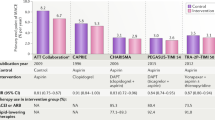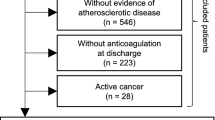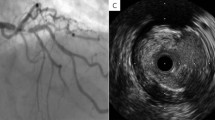Key Points
-
In noncardioembolic cerebrovascular disease (CVD), the use of antiplatelet agents rather than anticoagulants is recommended to reduce the risk of recurrent stroke and other cardiovascular events
-
Patients with prior noncardioembolic ischaemic stroke or transient ischaemic attack (TIA) can receive aspirin and clopidogrel in the setting of acute coronary syndrome (ACS) or percutaneous coronary intervention
-
New antiplatelet drugs investigated in the setting of ACS and secondary prevention should currently not be used in patients with prior ischaemic stroke or TIA
-
Duration of therapy should be individualized, considering the main determinant of risk (coronary or cerebrovascular), and the effectiveness, safety, and cost of drugs, as well as patient characteristics and preferences
-
In the setting of ischaemic stroke during antiplatelet therapy, if the patient's need for treatment offsets the risk of haemorrhagic conversion, aspirin plus clopidogrel seems to be the regimen of choice
-
If ischaemic stroke occurs during antiplatelet therapy, antiplatelet medications should not be abruptly suspended, particularly when therapy is recommended for an event such as ACS or stent implantation
Abstract
Atherothrombosis is the common underlying process for numerous progressive manifestations of cardiovascular disease, including coronary artery disease (CAD) and cerebrovascular disease (CVD). Antiplatelet therapy is the cornerstone of pharmacological management in patients with atherothrombosis. Over the past 20 years, major advances in antiplatelet pharmacotherapy have been made, particularly for the treatment of patients with CAD. The treatment of patients with concomitant CAD and CVD is complex, owing to their increased risk of both ischaemia and bleeding. When CVD arises from large artery atherosclerosis, antithrombotic therapies are essential to prevent stroke or transient ischaemic attack (TIA). However, the use of antithrombotic medications in patients with CVD can put them at high risk of intracranial haemorrhage. As such, the risk–benefit profile of various combinations of antiplatelet agents in patients with both CAD and CVD is uncertain. This Review provides a state-of-the-art account of the available evidence on antithrombotic therapies for the secondary prevention of atherothrombotic events in patients with concomitant CAD and CVD, particularly those with a history of noncardioembolic stroke or TIA.
This is a preview of subscription content, access via your institution
Access options
Subscribe to this journal
Receive 12 print issues and online access
$209.00 per year
only $17.42 per issue
Buy this article
- Purchase on Springer Link
- Instant access to full article PDF
Prices may be subject to local taxes which are calculated during checkout






Similar content being viewed by others
References
Hansson, G. K. Inflammation, atherosclerosis, and coronary artery disease. N. Engl. J. Med. 352, 1685–1695 (2005).
Yakubov, S. Polyvascular atherosclerotic disease: recognizing the risks and managing the syndrome. Curr. Med. Res. Opin. 25, 2631–2641 (2009).
Bhatt, D. L. et al. International prevalence, recognition, and treatment of cardiovascular risk factors in outpatients with atherothrombosis. JAMA 295, 180–189 (2006).
Suarez, C. et al. Influence of polyvascular disease on cardiovascular event rates. Insights From REACH Registry. Vasc. Med. 15, 259–265 (2010).
Capodanno, D., Ferreiro, J. L. & Angiolillo, D. J. Antiplatelet therapy: new pharmacological agents and changing paradigms. J. Thromb. Haemost. 11 (Suppl. 1), 316–329 (2013).
Angiolillo, D. J., Ueno, M. & Goto, S. Basic principles of platelet biology and clinical implications. Circ. J. 74, 597–607 (2010).
Franchi, F. & Angiolillo, D. J. Novel antiplatelet agents in acute coronary syndrome. Nat. Rev. Cardiol. 12, 30–47 (2015).
Baber, U. et al. Coronary thrombosis and major bleeding after PCI with drug-eluting stents: risk scores From PARIS. J. Am. Coll. Cardiol. 67, 2224–2234 (2016).
Matteau, A. et al. Balancing long-term risks of ischemic and bleeding complications after percutaneous coronary intervention with drug-eluting stents. Am. J. Cardiol. 116, 686–693 (2015).
Kernan, W. N. et al. Guidelines for the prevention of stroke in patients with stroke and transient ischemic attack: a guideline for healthcare professionals from the American Heart Association/American Stroke Association. Stroke 45, 2160–2236 (2014).
Adams, H. P. Jr et al. Classification of subtype of acute ischemic stroke. Definitions for use in a multicenter clinical trial. Stroke 24, 35–41 (1993).
Centres for Disease Control and Prevention. Underlying Cause of Death 1999–2014. CDC Wonder http://wonder.cdc.gov/ucd-icd10.html (2015).
Mozaffarian, D. et al. Heart disease and stroke statistics — 2015 update: a report from the American Heart Association. Circulation 131, e29–e322 (2015).
Kleindorfer, D. et al. Incidence and short-term prognosis of transient ischemic attack in a population-based study. Stroke 36, 720–723 (2005).
Johnston, S. C., Gress, D. R., Browner, W. S. & Sidney, S. Short-term prognosis after emergency department diagnosis of TIA. JAMA 284, 2901–2906 (2000).
Amarenco, P. et al. One-year risk of stroke after transient ischemic attack or minor stroke. N. Engl. J. Med. 374, 1533–1542 (2016).
Dhamoon, M. S., Sciacca, R. R., Rundek, T., Sacco, R. L. & Elkind, M. S. Recurrent stroke and cardiac risks after first ischemic stroke: the Northern Manhattan Study. Neurology 66, 641–646 (2006).
Lovett, J. K., Coull, A. J. & Rothwell, P. M. Early risk of recurrence by subtype of ischemic stroke in population-based incidence studies. Neurology 62, 569–573 (2004).
Kolominsky-Rabas, P. L., Weber, M., Gefeller, O., Neundoerfer, B. & Heuschmann, P. U. Epidemiology of ischemic stroke subtypes according to TOAST criteria: incidence, recurrence, and long-term survival in ischemic stroke subtypes: a population-based study. Stroke 32, 2735–2740 (2001).
Yusuf, S. et al. Effects of clopidogrel in addition to aspirin in patients with acute coronary syndromes without ST-segment elevation. N. Engl. J. Med. 345, 494–502 (2001).
Mehta, S. R. et al. Dose comparisons of clopidogrel and aspirin in acute coronary syndromes. N. Engl. J. Med. 363, 930–942 (2010).
Chen, Z. M. et al. Addition of clopidogrel to aspirin in 45,852 patients with acute myocardial infarction: randomised placebo-controlled trial. Lancet 366, 1607–1621 (2005).
Sabatine, M. S. et al. Addition of clopidogrel to aspirin and fibrinolytic therapy for myocardial infarction with ST-segment elevation. N. Engl. J. Med. 352, 1179–1189 (2005).
Steinhubl, S. R. et al. Early and sustained dual oral antiplatelet therapy following percutaneous coronary intervention: a randomized controlled trial. JAMA 288, 2411–2420 (2002).
CAPRIE Steering Committee. A randomised, blinded, trial of clopidogrel versus aspirin in patients at risk of ischaemic events (CAPRIE). Lancet 348, 1329–1339 (1996).
Bhatt, D. L. et al. Clopidogrel and aspirin versus aspirin alone for the prevention of atherothrombotic events. N. Engl. J. Med. 354, 1706–1717 (2006).
Roe, M. T. et al. Prasugrel versus clopidogrel for acute coronary syndromes without revascularization. N. Engl. J. Med. 367, 1297–1309 (2012).
Wiviott, S. D. et al. Prasugrel versus clopidogrel in patients with acute coronary syndromes. N. Engl. J. Med. 357, 2001–2015 (2007).
Montalescot, G. et al. Pretreatment with prasugrel in non-ST-segment elevation acute coronary syndromes. N. Engl. J. Med. 369, 999–1010 (2013).
Wallentin, L. et al. Ticagrelor versus clopidogrel in patients with acute coronary syndromes. N. Engl. J. Med. 361, 1045–1057 (2009).
Montalescot, G. et al. Prehospital ticagrelor in ST-segment elevation myocardial infarction. N. Engl. J. Med. 371, 1016–1027 (2014).
Bonaca, M. P. et al. Long-term use of ticagrelor in patients with prior myocardial infarction. N. Engl. J. Med. 372, 1791–1800 (2015).
Bhatt, D. L. et al. Intravenous platelet blockade with cangrelor during PCI. N. Engl. J. Med. 361, 2330–2341 (2009).
Harrington, R. A. et al. Platelet inhibition with cangrelor in patients undergoing PCI. N. Engl. J. Med. 361, 2318–2329 (2009).
Bhatt, D. L. et al. Effect of platelet inhibition with cangrelor during PCI on ischemic events. N. Engl. J. Med. 368, 1303–1313 (2013).
Tricoci, P. et al. Thrombin-receptor antagonist vorapaxar in acute coronary syndromes. N. Engl. J. Med. 366, 20–33 (2012).
Morrow, D. A. et al. Vorapaxar in the secondary prevention of atherothrombotic events. N. Engl. J. Med. 366, 1404–1413 (2012).
Mega, J. L. et al. Rivaroxaban in patients with a recent acute coronary syndrome. N. Engl. J. Med. 366, 9–19 (2012).
Tsai, T. T. et al. Validated contemporary risk model of acute kidney injury in patients undergoing percutaneous coronary interventions: insights from the National Cardiovascular Data Registry Cath-PCI Registry. J. Am. Heart Assoc. 3, e001380 (2014).
Abtahian, F. et al. Effect of prior stroke on the use of evidence-based therapies and in-hospital outcomes in patients with myocardial infarction (from the NCDR ACTION GWTG registry). Am. J. Cardiol. 107, 1441–1446 (2011).
Bhatt, D. L. et al. Comparative determinants of 4-year cardiovascular event rates in stable outpatients at risk of or with atherothrombosis. JAMA 304, 1350–1357 (2010).
Alberts, M. J. et al. Three-year follow-up and event rates in the international REduction of Atherothrombosis for Continued Health Registry. Eur. Heart J. 30, 2318–2326 (2009).
Ducrocq, G. et al. A history of stroke/transient ischemic attack indicates high risks of cardiovascular event and hemorrhagic stroke in patients with coronary artery disease. Circulation 127, 730–738 (2013).
Patrono, C., Garcia Rodriguez, L. A., Landolfi, R. & Baigent, C. Low-dose aspirin for the prevention of atherothrombosis. N. Engl. J. Med. 353, 2373–2383 (2005).
Antithrombotic Trialists' Collaboration. Collaborative meta-analysis of randomised trials of antiplatelet therapy for prevention of death, myocardial infarction, and stroke in high risk patients. BMJ 324, 71–86 (2002).
Antithrombotic Trialists' Collaboration. Collaborative overview of randomised trials of antiplatelet therapy — I: prevention of death, myocardial infarction, and stroke by prolonged antiplatelet therapy in various categories of patients. BMJ 308, 81–106 (1994).
The ESPS Group. The European Stroke Prevention Study (ESPS). Principal end-points. Lancet 2, 1351–1354 (1987).
Sivenius, J. et al. Antiplatelet treatment does not reduce the severity of subsequent stroke. European Stroke Prevention Study 2 Working Group. Neurology 53, 825–829 (1999).
Halkes, P. H., van Gijn, J., Kappelle, L. J., Koudstaal, P. J. & Algra, A. Aspirin plus dipyridamole versus aspirin alone after cerebral ischaemia of arterial origin (ESPRIT): randomised controlled trial. Lancet 367, 1665–1673 (2006).
Diener, H. C. et al. Effects of aspirin plus extended-release dipyridamole versus clopidogrel and telmisartan on disability and cognitive function after recurrent stroke in patients with ischaemic stroke in the Prevention Regimen for Effectively Avoiding Second Strokes (PRoFESS) trial: a double-blind, active and placebo-controlled study. Lancet Neurol. 7, 875–884 (2008).
Chamorro, A. TP receptor antagonism: a new concept in atherothrombosis and stroke prevention. Cerebrovasc. Dis. 27 (Suppl. 3), 20–27 (2009).
Bousser, M. G. et al. Terutroban versus aspirin in patients with cerebral ischaemic events (PERFORM): a randomised, double-blind, parallel-group trial. Lancet 377, 2013–2022 (2011).
Fox, K. A. & Chelliah, R. Clopidogrel: an updated and comprehensive review. Expert Opin. Drug Metab. Toxicol. 3, 621–631 (2007).
Ringleb, P. A., Bhatt, D. L., Hirsch, A. T., Topol, E. J. & Hacke, W. Benefit of clopidogrel over aspirin is amplified in patients with a history of ischemic events. Stroke 35, 528–532 (2004).
Diener, H. C. et al. Aspirin and clopidogrel compared with clopidogrel alone after recent ischaemic stroke or transient ischaemic attack in high-risk patients (MATCH): randomised, double-blind, placebo-controlled trial. Lancet 364, 331–337 (2004).
Bhatt, D. L. et al. Patients with prior myocardial infarction, stroke, or symptomatic peripheral arterial disease in the CHARISMA trial. J. Am. Coll. Cardiol. 49, 1982–1988 (2007).
Hankey, G. J. et al. Effect of clopidogrel plus ASA versus ASA early after TIA and ischaemic stroke: a substudy of the CHARISMA trial. Int. J. Stroke 6, 3–9 (2011).
Kennedy, J. et al. Fast assessment of stroke and transient ischaemic attack to prevent early recurrence (FASTER): a randomised controlled pilot trial. Lancet Neurol. 6, 961–969 (2007).
Wang, Y. et al. Clopidogrel with aspirin in acute minor stroke or transient ischemic attack. N. Engl. J. Med. 369, 11–19 (2013).
Wang, Y. et al. Clopidogrel with aspirin in acute minor stroke or transient ischemic attack (CHANCE): 1-year outcomes. Circulation 132, 40–46 (2015).
Tello-Montoliu, A., Tomasello, S. D. & Angiolillo, D. J. Prasugrel. Adv. Cardiol. 47, 39–63 (2012).
Hira, R. S. et al. Frequency and practice-level variation in inappropriate and nonrecommended prasugrel prescribing: insights from the NCDR PINNACLE registry. J. Am. Coll. Cardiol. 63, 2876–2877 (2014).
Capodanno, D., Dharmashankar, K. & Angiolillo, D. J. Mechanism of action and clinical development of ticagrelor, a novel platelet ADP P2Y12 receptor antagonist. Expert Rev. Cardiovasc. Ther. 8, 151–158 (2010).
James, S. K. et al. Ticagrelor versus clopidogrel in patients with acute coronary syndromes and a history of stroke or transient ischemic attack. Circulation 125, 2914–2921 (2012).
Verheugt, F. W. Beware of novel antiplatelet therapy in acute coronary syndrome patients with previous stroke. Circulation 125, 2821–2823 (2012).
Bonaca, M. P. et al. Design and rationale for the Prevention of Cardiovascular Events in Patients With Prior Heart Attack Using Ticagrelor Compared to Placebo on a Background of Aspirin-Thrombolysis in Myocardial Infarction 54 (PEGASUS-TIMI 54) trial. Am. Heart J. 167, 437–444.e5 (2014).
Udell, J. A. et al. Long-term dual antiplatelet therapy for secondary prevention of cardiovascular events in the subgroup of patients with previous myocardial infarction: a collaborative meta-analysis of randomized trials. Eur. Heart J. 37, 390–399 (2016).
Johnston, S. C. et al. Ticagrelor versus aspirin in acute stroke or transient ischemic attack. N. Engl. J. Med. http://dx.doi.org/10.1056/NEJMoa1603060 (2016).
Franchi, F., Rollini, F., Muniz-Lozano, A., Cho, J. R. & Angiolillo, D. J. Cangrelor: a review on pharmacology and clinical trial development. Expert Rev. Cardiovasc. Ther. 11, 1279–1291 (2013).
Angiolillo, D. J. et al. Impact of cangrelor overdosing on bleeding complications in patients undergoing percutaneous coronary intervention: insights from the CHAMPION trials. J. Thromb. Thrombolysis 40, 317–322 (2015).
Alonso-Coello, P. et al. Antithrombotic therapy in peripheral artery disease: Antithrombotic Therapy and Prevention of Thrombosis, 9th ed: American College of Chest Physicians Evidence-Based Clinical Practice Guidelines. Chest 141 (2 Suppl.), e669S–e690S (2012).
Tendera, M. et al. ESC guidelines on the diagnosis and treatment of peripheral artery diseases: document covering atherosclerotic disease of extracranial carotid and vertebral, mesenteric, renal, upper and lower extremity arteries: the Task Force on the Diagnosis and Treatment of Peripheral Artery Diseases of the European Society of Cardiology (ESC). Eur. Heart J. 32, 2851–2906 (2011).
Gotoh, F. et al. Cilostazol stroke prevention study: a placebo-controlled double-blind trial for secondary prevention of cerebral infarction. J. Stroke Cerebrovasc. Dis. 9, 147–157 (2000).
Shinohara, Y. et al. Cilostazol for prevention of secondary stroke (CSPS 2): an aspirin-controlled, double-blind, randomised non-inferiority trial. Lancet Neurol. 9, 959–968 (2010).
Bonaca, M. P. et al. New ischemic stroke and outcomes with vorapaxar versus placebo: results from the TRA 2 degrees P-TIMI 50 trial. J. Am. Coll. Cardiol. 64, 2318–2326 (2014).
Hart, R. G., Halperin, J. L. & Weitz, J. I. Vorapaxar, combination antiplatelet therapy, and stroke. J. Am. Coll. Cardiol. 64, 2327–2329 (2014).
Muniz-Lozano, A., Rollini, F., Franchi, F. & Angiolillo, D. J. Update on platelet glycoprotein IIb/IIIa inhibitors: recommendations for clinical practice. Ther. Adv. Cardiovasc. Dis. 7, 197–213 (2013).
Windecker, S. et al. 2014 ESC/EACTS guidelines on myocardial revascularization: the Task Force on Myocardial Revascularization of the European Society of Cardiology (ESC) and the European Association for Cardio-Thoracic Surgery (EACTS). Eur. Heart J. 35, 2541–2619 (2014).
Abciximab in Ischemic Stroke Investigators. Abciximab in acute ischemic stroke. A randomized, double-blind, placebo-controlled, dose-escalation study. Stroke 1, 601–609 (2000).
Capodanno, D., Giacchi, G. & Tamburino, C. Novel drugs for oral anticoagulation pharmacotherapy. Expert Rev. Cardiovasc. Ther. 10, 473–488 (2012).
Alexander, J. H. et al. Apixaban with antiplatelet therapy after acute coronary syndrome. N. Engl. J. Med. 365, 699–708 (2011).
Hills, N. K. & Johnston, S. C. Trends in usage of alternative antiplatelet therapy after stroke and transient ischemic attack. Stroke 39, 1228–1232 (2008).
Roffi, M. et al. 2015 ESC guidelines for the management of acute coronary syndromes in patients presenting without persistent ST-segment elevation: Task Force for the Management of Acute Coronary Syndromes in Patients Presenting without Persistent ST-Segment Elevation of the European Society of Cardiology (ESC). Eur. Heart J. 37, 267–315 (2015).
Yeh, R. W. et al. Benefits and risks of extended duration dual antiplatelet therapy after PCI in patients with and without acute myocardial infarction. J. Am. Coll. Cardiol. 65, 2211–2221 (2015).
Author information
Authors and Affiliations
Contributions
D.C. and D.J.A. researched data for the article, discussed its content, wrote the manuscript, and reviewed and edited the article before submission. M.A. contributed to discussions of content.
Corresponding author
Ethics declarations
Competing interests
D.C. declares receiving consultant and/or speaker honoraria from Abbott Vascular, Aspen, AstraZeneca, Bayer, Daiichi-Sankyo, Eli Lilly, Sanofi-Aventis, and Stentys. M.A. declares receiving consultant and/or speaker honoraria from Avanir, Boehringer-Ingelheim, Bristol Myers Squibb, Chiesi, Daiichi-Sankyo, Genentech, Janssen, Medtronic, Nestec, Portola, and Pzifer; and royalty payments from Duke University. D.J.A. declares receiving payments as an individual for consulting fees or honoraria from Abbott Vascular, AstraZeneca, Daiichi-Sankyo, Eli Lilly, Merck, PLx Pharma, Sanofi, and The Medicines Company; and for participation in review activities from CeloNova, Johnson & Johnson, and St. Jude Medical; and receiving institutional payments for grants from AstraZeneca, CSL Behring, Daiichi-Sankyo, Eli Lilly, Gilead, GlaxoSmithKline, Janssen Pharmaceuticals, Novartis, Osprey Medical, and The Medicines Company.
Rights and permissions
About this article
Cite this article
Capodanno, D., Alberts, M. & Angiolillo, D. Antithrombotic therapy for secondary prevention of atherothrombotic events in cerebrovascular disease. Nat Rev Cardiol 13, 609–622 (2016). https://doi.org/10.1038/nrcardio.2016.111
Published:
Issue Date:
DOI: https://doi.org/10.1038/nrcardio.2016.111
This article is cited by
-
Aspirin with Low-Dose Ticagrelor or with Low-Dose Rivaroxaban for Secondary Prevention: A Cost per Outcome Analysis
American Journal of Cardiovascular Drugs (2022)
-
Predictors of stent thrombosis and their implications for clinical practice
Nature Reviews Cardiology (2019)
-
Prevention of atherothrombotic events in patients with diabetes mellitus: from antithrombotic therapies to new-generation glucose-lowering drugs
Nature Reviews Cardiology (2019)
-
Aspirin-free strategies in cardiovascular disease and cardioembolic stroke prevention
Nature Reviews Cardiology (2018)



